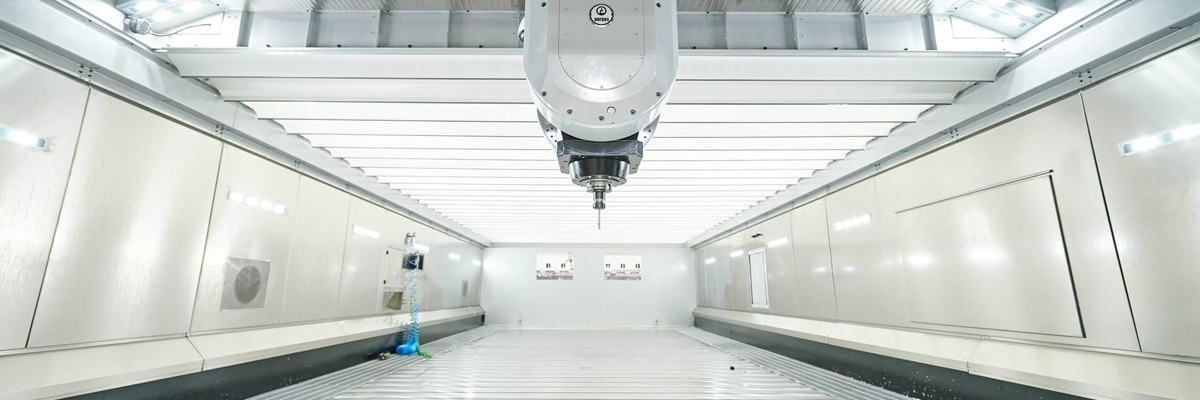Simulation and Tooling Secure High-Value Work
Simulation software and careful attention to tooling parameters have enabled Major Tool to take on ambitious projects with its complex machinery.
Large workpieces produced from Inconel and JBK-75 (an iron-nickel alloy related to A-286) at Major Tool and Machine can be valued at more than a machinist’s yearly salary. At material costs this high, scrap is unacceptable, so machinists and programmers must ascertain the success of any program before running it. The shop therefore relies heavily on its software suite, leveraging TDM Systems’ software to design tool packages and testing its part programs with CGTech’s Vericut simulation software.
Big-Picture Thinking for Large-Format Machines
Major Tool and Machine never had a catastrophic failure that sent it shopping for a software suite— leadership simply realized in the early 2000s that a combination of high-value parts, untested programs and haphazard tooling management would lead to disaster.
This has only grown truer by the year, as the company’s machining department has adopted more complicated machines. These include multiple Gruppo Parpas five-axis high-speed gantry mills, one of which boasts 20 meters of X-axis travel and several of which are paired as part of a flexible manufacturing cell; a Schiess Froriep Spheromill vertical turret lathe with a 140,000 lb. table capacity; a Mazak Integrex e670 multitasking machine; and a large Dorries Scharmann Schiess FZG6 gantry mill-turn.
To effectively manage the equipment in its machining department, Major Tool has outfitted its machines with real-time production monitoring, setting up displays at each machine and workcenter to provide status reports on jobs that are staged and running. It also deploys Renishaw probes to assist setup and conduct in-process measurement, ensuring that parts large and small are held to necessary tolerances.
This is also where the shop’s tooling and simulation software comes into play. Major Tool uses TDM Systems tool management software and offline presetters from Zoller to build tool packages with setup parameters and streamline the setup process. The shop also makes heavy use of CGTech’s Vericut simulation software, going so far as to require simulation of each job in the machining department before it can be sent to a machine.
Digital Twin Simulation Leads to Physical Benefits
Simulating every job has led the shop to create or obtain digital twins of all its tooling, workpieces and machine tools. While obtaining digital twin technology for new machines is often as simple as asking for computer models of machines upon purchase, achieving the proper level of verisimilitude for older machines has required extracting machine “archive” files from the controllers and importing them into Vericut. This enables the software to work with an exact replica of machines’ operating parameters, custom macros, offset values and other data.
Using this data, Major Tool’s programmers can simulate part programs. Crash detection features indicate if the program will cause collision issues for the fixture, table or spindle, with the programmers using parameters and zones to detect the areas most at risk for crashing.
The software’s Auto-Diff feature can also compare the cut model to the stock model. If the program will gouge or cut in excess of the planned version — or leave more stock than needed — Vericut will highlight these regions for program revision. The resolution for this comparison can be as small as 0.001 inch, according to Brandon Lee, machining manager at Major Tool — though most of Major Tool’s projects range in tolerance from 0.001 to 0.005 inch.
Setting Up Tooling Success
Running all the simulations in the world won’t matter if the tooling for the job isn’t set up the same way it is in Vericut. Major Tool’s solution for this issue is twofold: software and RFID chips.
For each part, the shop’s tool engineers create a feature-by-feature tooling package within TDM Systems, importing it into the shop’s Siemens NX CAM. This data serves as the basis of a “TLS” file, which includes tool-specific parameters such as gage length and diameter. Machinists can download this file along with the part program, probing tools to compare them to the TLS file.
Recently, Major Tool has attached RFID chips to its toolholders to make this process more efficient. These chips allow the shop’s Zoller presetters to upload tool IDs, length and diameter offsets, wear data and other setup info directly to the toolholder. When inserted into a machine, the control can then read the RFID chip and adjust parameters accordingly — a boon for high-speed and automated machines. The machine can also upload information to the chips, providing a simple way to track tool wear.
Training Leaves Little to Chance
To ensure its programmers can make full use of the software at their disposal, Major Tool assigns new hires to spend time in the programming department acclimating to the full suite of software. The newcomers then take a four-day online training course through CGTech. Through examples and training tutorials, the new programmers learn how to use Vericut’s major features, as well as how to import new machines and processes into the software.
“Vericut has become a necessity here at Major Tool and Machine for ensuring the machining process of high-value parts is safe and achievable,” says Chad Eastman, CAD/CAM applications engineer. “It has saved Major Tool and Machine countless hours and dollars due to unseen setup issues, machine crashes and inoperable toolpaths. Having this technology to pre-plan and verify processes helps programmers hand off NC programs to the floor with confidence and fewer sleepless nights.”
Landscape Photo Credit: Major Tool and Machine
Originally Published in Modern Machine Shop. 4/21/2023
 Germany
Germany Italy
Italy USA
USA South Korea
South Korea UK
UK India
India France
France China
China Japan
Japan
